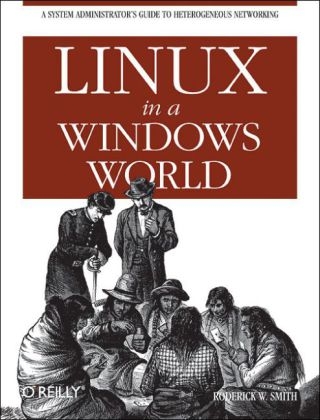
Linux in a Windows World
O'Reilly Media (Verlag)
978-0-596-00758-4 (ISBN)
- Titel ist leider vergriffen;
keine Neuauflage - Artikel merken
It began simply enough. A young Finnish student at the University of Helsinki named Linus Torvalds decided to develop his own computer operating system merely as a hobby. More than a decade later, this same operating system has caused nothing short of a revolution in the world of computers. Now known as Linux, Torvalds' creation was largely dismissed in the 1990s by tech pundits who claimed that it was unsuitable for the general public's computing needs. If they only knew how wrong they were! After a series of tweaks from excited developers around the world, Linux's unparalleled functionality and adaptability have now made it the main alternative to Unix and Microsoft Windows operating systems. And with good reason. System administrators realize that this robust alternative can greatly improve their operating system's reliability - and save them money, too. Linux systems are even less vulnerable to attacks by computer viruses and worms. Not surprisingly, businesses, government agencies, schools, and a wealth of other institutions are all looking to Linux to replace the Windows desktop for these same benefits.
Linux in a Windows World takes an in-depth look at exactly how Linux can be brought into an organization that's currently based on Microsoft Windows systems. Featuring a litany of insider tips and techniques, Linux in a Windows World dispenses all the practical advice you need to migrate to this revolutionary open source software. Author Roderick W. Smith, himself a renowned system administrator and Linux convert, understands that the skills required to install, deploy, and maintain Linux are not easy to find. That's why he has tapped the absolute best source of information available: the Linux server experts who have made it their life's work to build and manage the Linux system. The latest in O'Reilly's line of bestselling Linux titles, Linux in a Windows World is an invaluable companion for any system administrator interested in integrating Linux into their Windows environment.
Roderick W. Smith is a well-known system administrator with a monthly Linux Magazine column and several highly respected books, including Advanced Linux Networking and Linux Power Tools.
Preface; Part I. Linux's Place in a Windows Network; 1. Linux's Features; Where Linux Fits in a Network; Linux as a Server Linux on the Desktop; Comparing Linux and Windows Features 2. Linux Deployment Strategies; Linux Server Options; Linux Desktop Migration; Linux and Thin Clients; Part II. Sharing Files and Printers; 3. Basic Samba Configuration; Installing Samba The Samba Configuration File Format; Identifying the Server Setting Master Browser Options; Setting Password Options; 4. File and Printer Shares; Common File Share Options; Printing with CUPS Creating a Printer Share; Delivering Printer Drivers to Windows Clients; Example Shares; 5. Managing a NetBIOS Network with Samba Enabling Domain Controller Functions; Enabling NBNS Functions Assuming Master Browser Duties; 6. Linux as an SMB/CIFS Client Using NetBIOS Name Resolution; Accessing File Shares; Printing to Printer Shares; Configuring GUI Workgroup Browsers; Part III. Centralized Authentication Tools; 7. Using NT Domains for Linux Authentication; The Principles Behind Winbind; Samba Winbind Configuration; PAM and NSS Winbind Options; Winbind in Action 8. Using LDAP; The Principles Behind LDAP; Configuring an OpenLDAP Server Creating a User Directory; Configuring Linux to Use LDAP for Login Authentication; Configuring Windows to Use LDAP for Login Authentication; 9. Kerberos Configuration and Use Kerberos Fundamentals; Linux Kerberos Server Configuration; Kerberos Application Server Configuration; Linux Kerberos Client; Configuration; Windows Kerberos Tools; Part IV. Remote Login Tools; 10. Remote Text-Mode Administration and Use; What Can Text-Mode Logins Do?; SSH Server Configuration; Telnet Server Configuration; Windows Remote-Login Tools; 11. Running GUI Programs Remotely; What Can GUI Logins Do?; Using Remote X Access Encrypting X by SSH Tunneling; VNC Configuration and Use; ; Running Windows Programs from Linux; 12. Linux Thin Client Configurations; The Role of Thin Client Computing; Hardware Requirements; Linux as a Server for Thin Clients; Linux as a Thin Client; Part V. Additional Server Programs; 13. Configuring Mail Servers; Linux Mail Server Options; Configuring Sendmail Configuring Postfix; Configuring POP and IMAP Servers Scanning for Spam, Worms, and Viruses; Supplementing a Microsoft Exchange Server Using Fetchmail; 14. Network Backups; Backup Strategies Backing Up the Linux System; Backing Up with Samba Backing Up with AMANDA 15. Managing a Network with Linux; Delivering IP Addresses with DHCP; Delivering Names with DNS Keeping Clocks Synchronized with NTP Part VI. Appendixes; A. Configuring PAM; B. Linux on the Desktop Index
| Erscheint lt. Verlag | 15.3.2005 |
|---|---|
| Reihe/Serie | O'Reilly Ser. |
| Verlagsort | Sebastopol |
| Sprache | englisch |
| Einbandart | kartoniert |
| Themenwelt | Informatik ► Betriebssysteme / Server ► Unix / Linux |
| ISBN-10 | 0-596-00758-2 / 0596007582 |
| ISBN-13 | 978-0-596-00758-4 / 9780596007584 |
| Zustand | Neuware |
| Haben Sie eine Frage zum Produkt? |
aus dem Bereich


